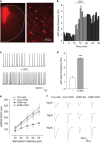Disrupted Glutamatergic Transmission in Prefrontal Cortex Contributes to Behavioral Abnormality in an Animal Model of ADHD
- PMID: 28176786
- PMCID: PMC5561342
- DOI: 10.1038/npp.2017.30
Disrupted Glutamatergic Transmission in Prefrontal Cortex Contributes to Behavioral Abnormality in an Animal Model of ADHD
Abstract
Spontaneously hypertensive rats (SHR) are the most widely used animal model for the study of attention deficit hyperactivity disorder (ADHD). Here we sought to reveal the neuronal circuits and molecular basis of ADHD and its potential treatment using SHR. Combined electrophysiological, biochemical, pharmacological, chemicogenetic, and behavioral approaches were utilized. We found that AMPAR-mediated synaptic transmission in pyramidal neurons of prefrontal cortex (PFC) was diminished in SHR, which was correlated with the decreased surface expression of AMPAR subunits. Administration of methylphenidate (a psychostimulant drug used to treat ADHD), which blocks dopamine transporters and norepinephrine transporters, ameliorated the behavioral deficits of adolescent SHR and restored AMPAR-mediated synaptic function. Activation of PFC pyramidal neurons with a CaMKII-driven Gq-coupled designer receptor exclusively activated by designer drug also led to the elevation of AMPAR function and the normalization of ADHD-like behaviors in SHR. These results suggest that the disrupted function of AMPARs in PFC may underlie the behavioral deficits in adolescent SHR and enhancing PFC activity could be a treatment strategy for ADHD.
Figures





References
-
- Arnsten AF (2009). Toward a new understanding of attention-deficit hyperactivity disorder pathophysiology: an important role for prefrontal cortex dysfunction. CNS Drugs 23: 33–41. - PubMed
-
- Arnsten AF, Rubia K (2012). Neurobiological circuits regulating attention, cognitive control, motivation, and emotion: disruptions in neurodevelopmental psychiatric disorders. J Am Acad Child Adolesc Psychiatry 51: 356–367. - PubMed
MeSH terms
Substances
Grants and funding
LinkOut - more resources
Full Text Sources
Other Literature Sources
Medical
Miscellaneous

